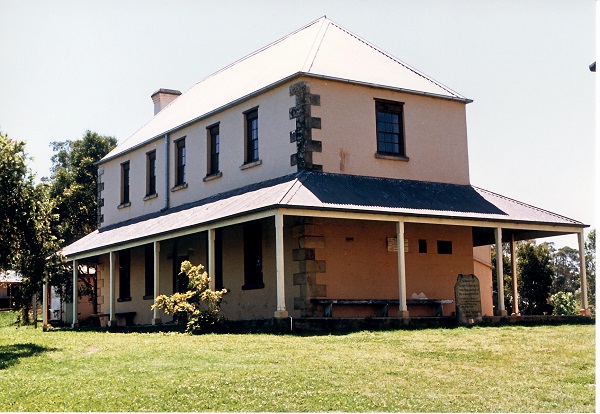Hawkesbury People & Places
Macquarie Schoolhouse
School
This heritage listed building located at 43 Macquarie Road, Wilberforce was constructed at the direction of Lachlan Macquarie, governor of the British colony of New South Wales and was completed in 1820, replacing an earlier structure. It was one of a number of similar buildings designed to serve the dual purpose of providing a schoolroom and accommodation for the schoolmaster as well as a place of Sunday worship for the town and surrounding areas.
The adjacent St. John’s Anglican Church was completed in 1858 by John Wenban with funds raised by local subscription. Nearby, Wilberforce Cemetery dates from 1811 with the first recorded burial taking place in December of that year and includes many members of the first, second and third fleets as well as generations of Wilberforce families.
Source: Macquarie Schoolhouse Website
This year 2020, marks the 200th anniversary of the completion of the building and celebrations are planned for the weekend of the 3 and 4 October. See the website for further information on the planned celebrations and the history of the schoolhouse.

Macquarie Schoolhouse showing the new iron roof which replaced an earlier structure destroyed by fire in 1985. At the side of the building is the gravestone of John Howorth who was buried on the banks of the Hawkesbury River in 1804, the stone was relocated to the grounds of the schoolhouse by Hawkesbury Historical Society in 1960. Cathy McHardy October 1990.
Source: NSW State Heritage Inventory
Excerpt from the NSW Heritage Database
Macquarie’s Instructions from the Colonial Office included not just the establishment of towns but also the creation of schools, a policy with which Macquarie was in complete agreement. His Order of 11 May 1811 strongly recommended to parents and family heads ‘The Education and Instruction of the Youth of both Sexes being an Object of the utmost Importance, as laying the Foundation of many Advantages to the rising Generations’. Macquarie encouraged local residents to fund and establish schools themselves but also assisted with government funds. (Barkley & Nichols, 1994, p. 45)
The order encouraged the establishment of schoolhouses at the initiative of local communities and promised to contribute £25 of government money to each schoolhouse. At the same time, he directed that settlers should no longer bury their dead on their farms but in the burial grounds consecrated and measured out ‘some time since’ in places such as Wilberforce. (Sydney Gazette, 18 May 1811, p. 1). Schoolhouses were often used for religious purposes until churches were erected near them in the 1850s. These combined schoolhouses, chapels and schoolmaster’s residences were a feature of early Macquarie towns on the Hawkesbury. They were built at Castlereagh, Wilberforce, Pitt Town and Richmond often sited in commanding positions with a square nearby. (HRA, 1, X, pps. 692-3).
Reverend Cartwright was paid £10 before 1 July 1812 for ‘inclosing the Burial Ground at the Township of Wilberforce’. (Sydney Gazette, 24 Oct 1812, p. 2) Macquarie’s journal noted he visited Wilberforce on 21 May 1813 to mark the site for a new schoolhouse. (Waymark, 1970, np). The Government contributed £50 towards ‘Building a Government temporary Chapel and School House, in the Township of Wilberforce’ in 1813. (Sydney Gazette, 23 Oct 1813, p. 2). On 28 April 1814, he reported that schoolhouses, which would serve as temporary chapels, had already been erected at various places including Wilberforce. (HRA, I, 8, 154) In 1819, a new brick building replaced the earlier temporary one (Wymark, 1970, np).
By 30 September 1819, John Brabyn had been paid £200 for ’erecting a School-house and temporary Place of Worship at Wilberforce’. (Sydney Gazette, 8 Jan 1820, p. 2) On 31 May 1820, D Wentworth paid Brabyn an additional £85/16/1 for enlarging and completing the schoolhouse. (Wentworth Papers, ML D1, p. 217d) This may have funded the skillion at the rear. The skillion addition seems to have been an afterthought to accommodate the schoolmaster but seems to be almost contemporary with the main building as the brick work and fire place are bonded into the main building. The original roof was of open timberwork with three tie beams. Shutters originally protected the windows. At a later stage, verandahs were added on the western, southern and part of the eastern side. (Wymark, 1970, np)
In September 1821, the Sydney Gazette reported that there were ’thriving and ably-conducted Public Schools’ at Wilberforce, Pitt Town and Richmond. (Sydney Gazette, 29 Sept 1821, p. 2) The Schoolmaster at Wilberforce was William Gow who lived in the lower rooms. The school continued to operate throughout the 1820s. (HRA, I, 10, p. 582) Total enrolments varied between 30 and 40 pupils. (HRA, I, 14, pps. 53-4; HRA, I, 15, pps. 224-5)
Location of Macquarie Schoolhouse
Categories for Macquarie Schoolhouse
Related Locations of Macquarie Schoolhouse
People Related to Macquarie Schoolhouse
You are welcome to add a comment, provide further information or suggest a correction, relevant to the history of this name.
Please make your comment below. PLEASE NOTE that comments are moderated and only relevant comments will be published
Property Research Service
Have you ever wondered when your house was built or who has owned your property over the years?
